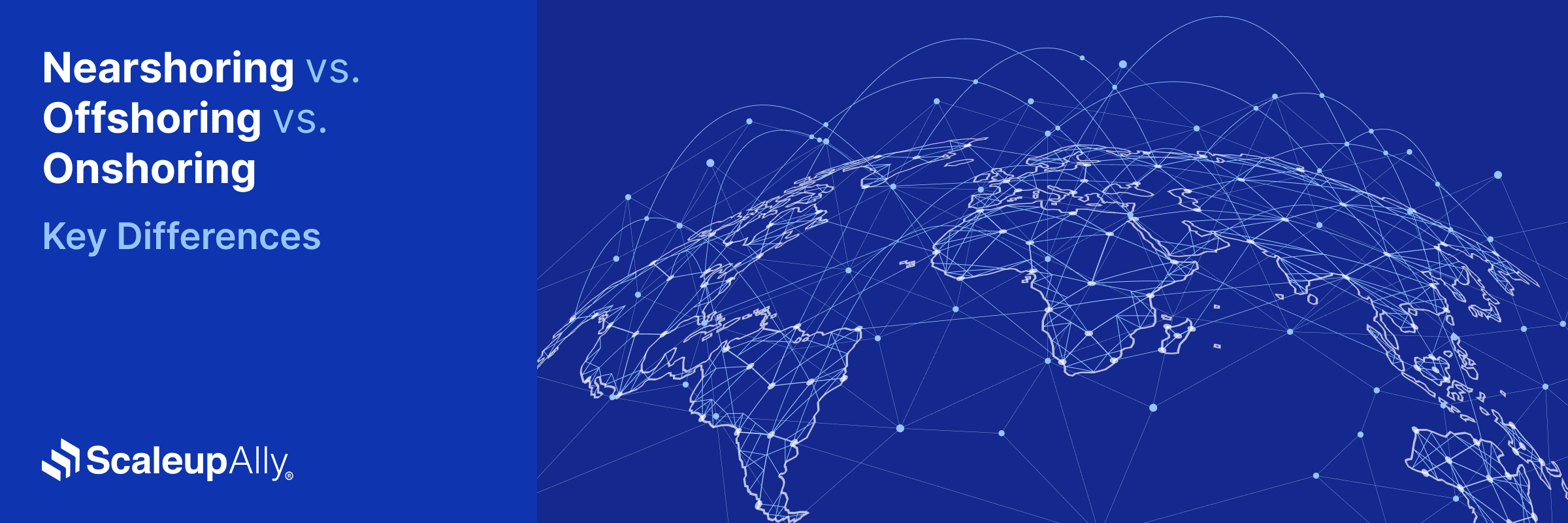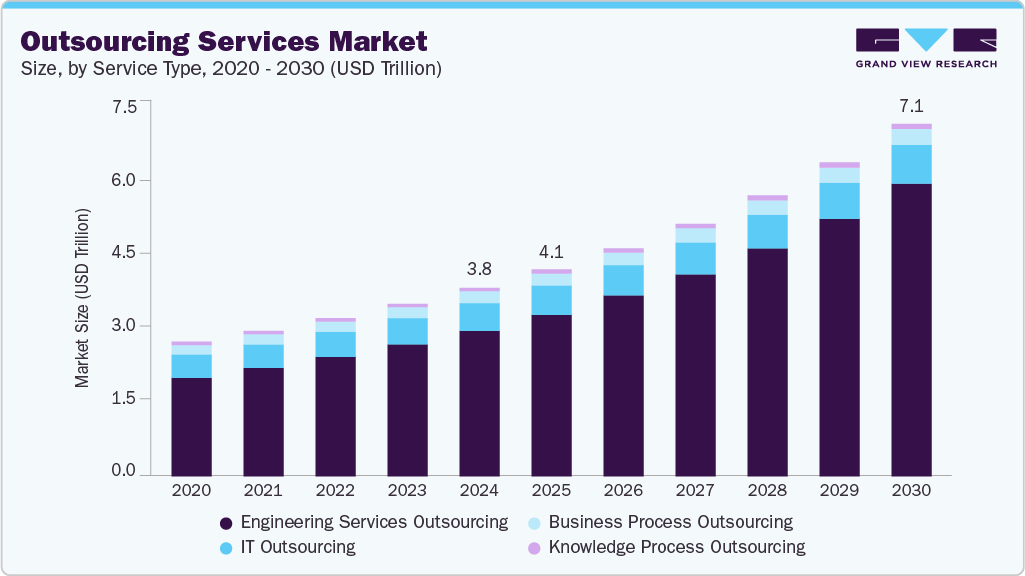
Nearshoring vs. Offshoring vs. Onshoring: Key Differences
ScaleupAlly Team | September 10, 2025 , 11 min read
Table Of Content
Do you face a choice between nearshoring, offshoring, and onshoring for your business operations? Companies often reach a point where in-house resources no longer cover growth demands, so they outsource. The problem is that each model comes with trade-offs: offshoring offers cost advantages but may introduce time zone or cultural barriers, nearshoring provides regional familiarity but can limit vendor options, and onshoring maximizes oversight while raising costs.
Without a clear framework, companies risk choosing an approach that doesn’t align with their priorities. This article breaks down nearshoring vs. offshoring vs. onshoring, explains their differences, and highlights when each model works best.
Key Takeaways
- Outsourcing models differ mainly by location: onshoring, nearshoring, and offshoring.
- Onshoring offers maximum control and compliance but comes with higher costs.
- Nearshoring balances affordability with accessibility and cultural alignment.
- Offshoring delivers the greatest cost savings and scalability but needs stronger oversight.
- The right choice depends on a company’s budget, compliance needs, and collaboration goals.
- A hybrid approach can combine all three models to balance cost, control, and efficiency.
What is onshoring, nearshoring, and offshoring?
Outsourcing lets companies delegate specific business functions such as IT services, customer support, or production to external providers. The approach now serves as a central strategy for organizations that seek flexibility, access to talent, and lower costs. Within outsourcing, three location-based models dominate: onshoring, nearshoring, and offshoring. For example, many companies rely on nearshore software development services to balance affordability with collaboration and cultural alignment. Others build dedicated offshore development centers to tap into global expertise at scale while keeping long-term control and efficiency in mind.
Each model defines where the work occurs and directly affects communication, cost, and regulatory alignment. According to research,, The global outsourcing services market is estimated at USD 3.8 trillion in 2024 and is projected to rise to USD 7.11 trillion by 2030, exhibiting a compound annual growth rate (CAGR) of 11.3%.

Onshoring
Onshoring refers to outsourcing business processes to third-party providers located within the same country. It’s often called domestic outsourcing. Companies choose this model to simplify compliance, maintain cultural and linguistic alignment, and retain closer oversight. For example, a U.S.-based company might outsource development to a partner in Texas while its headquarters is in California. While this method doesn’t always deliver best cost savings, it offers stability and easier collaboration.
Pros:
- Seamless communication due to shared language and time zones
- Strong cultural alignment and familiarity with local market conditions
- Easier compliance with national laws and regulations
- Higher degree of control and oversight
Cons:
- Generally higher labor costs compared to nearshore or offshore options
- Limited talent pool, especially for niche technical skills
- Reduced flexibility in scaling quickly
Although onshoring is the most expensive model, it offers the greatest control. Highly regulated sectors like finance, banking, healthcare, and government, often choose onshore outsourcing because compliance and security outweigh cost concerns. Onshoring also protects brand reputation, since teams operate under familiar standards.
Nearshoring
Nearshoring means outsourcing to nearby or neighboring countries, usually within a similar time zone. This model strikes a balance between cost savings and collaboration. For U.S. firms, common nearshore partners include Mexico, Brazil, or other Latin American nations, while European firms often nearshore to Eastern Europe. Nearshoring makes frequent face-to-face meetings feasible and reduces the risk of cultural misunderstandings.
Nearshoring has become a popular option for IT and software development projects, especially for companies that need ongoing collaboration. New technologies like AI influencer generator are also helping companies create digital assets and marketing content, offering a balance between cost and flexibility.
Pros:
- Geographic proximity allows easier travel and collaboration
- Better time zone overlap compared to offshoring
- Cultural and linguistic similarities reduce communication barriers
- Moderate cost savings compared to onshoring
Cons:
- Fewer vendor options compared to offshoring
- Some differences in laws and regulations may still complicate contracts
- Not always the cheapest option, cost savings vary by region
Nearshoring has become a popular option for IT and software development projects, especially for companies that need ongoing collaboration. It allows for quick adjustments and stronger team cohesion while keeping costs under control. However, the limited number of high-quality vendors in some regions can make the selection process more competitive.
Offshoring
Offshoring involves outsourcing work to distant countries, often across continents. Popular offshore destinations include India, China, the Philippines, and Ukraine. Companies often partner trusted providers to access specialized expertise in offshore markets.
The model is primarily chosen for cost reduction and access to a vast global talent pool. Offshoring also supports round-the-clock operations due to big time zone differences, which can be an advantage for companies requiring continuous workflow.
Pros:
- Great cost savings due to lower labor costs
- Access to a large and diverse pool of skilled professionals
- 24/7 operations possible through time zone differences
- High scalability for large projects
Cons:
- Time zone gaps may limit real-time collaboration
- Language and cultural differences can cause communication issues
- Higher risks around data security and regulatory compliance
- Requires stronger management and quality control
Offshoring is especially common in industries like IT support, software development, and large-scale manufacturing. While the savings can be substantial, companies must carefully evaluate vendor reliability, communication strategies, and legal protections. With the right controls in place, offshoring can deliver exceptional value and global expertise at a fraction of domestic costs. You can read more about offshore software development to understand how businesses maximize these advantages while managing the risks.
Key differences between each model
Each model offers specific advantages and trade-offs depending on priorities such as cost, talent, communication, and compliance. While the methods share the same core idea of outsourcing, their impact differs greatly once location comes into play. The comparison below highlights the main differences that influence business decisions. When evaluating nearshoring vs. offshoring vs. onshoring, companies should focus on the following elements:
- Cost. Labor expenses, overhead, and taxation.
- Talent availability. Size, quality, and specialization of the workforce.
- Communication. Time zone overlap, language, and cultural alignment.
- Control and oversight. The ability to monitor work and maintain standards.
- Legal and compliance. Alignment with domestic or international regulations.
- Travel and logistics. The ease of visiting teams and coordinating in person.
| Factor | Onshoring | Nearshoring | Offshoring |
|---|---|---|---|
| Cost | Highest – domestic rates apply | Moderate – lower than onshore, higher than offshore | Lowest – best labor savings possible |
| Talent pool | Limited to domestic market | Broader regional access, growing IT hubs | Vast global talent pool, highly specialized |
| Communication | Seamless – same language & time zone | Strong – overlapping hours, cultural similarities | Challenging – time zones, language, cultural differences |
| Control/oversight | Easy – face-to-face and site visits | Moderate – occasional travel feasible | Harder – requires stronger management systems |
| Legal/compliance | Simple – domestic laws apply | Regional alignment, fewer barriers | Complex – international data/security concerns |
| Travel logistics | Easiest – local access | Short-haul trips possible | Long-haul travel required, higher cost |
The key takeaway is that each model aligns with different business priorities. Onshoring favors control and compliance, nearshoring balances cost with accessibility, and offshoring maximizes savings and scalability but requires careful management. The best option depends less on the model itself and more on a company’s budget, operational needs, and strategic goals.
How to choose the right model
Once the differences are clear, the next step is to decide which outsourcing model fits best with your business goals. The choice between onshoring, nearshoring, and offshoring depends less on the definitions and more on the priorities driving your strategy. Some companies need maximum control, others prioritize cost efficiency, while many look for a balance that supports scalability without losing accessibility.
When onshoring works best
Onshoring is most suitable when projects involve sensitive data, legal restrictions, or require continuous oversight. Companies in highly regulated industries often select this model to minimize compliance risks. Beyond regulation, onshoring also suits businesses that want to preserve brand reputation by keeping outsourced work within the same cultural and linguistic environment as their customers.
While this model carries the highest costs due to domestic labor rates and overhead expenses, many organizations see the premium as worthwhile for peace of mind and easier collaboration. It can also benefit smaller firms that need outsourcing flexibility but lack the infrastructure to manage distant vendors. In these cases, the higher price translates into stability, smoother integration, and lower risk of disruption.
When nearshoring is the better fit
Nearshoring offers more than just a compromise between cost and control, it is a great choice for companies that seek to strengthen collaboration while reducing complexity. This model is especially suitable for organizations with distributed teams that require overlapping working hours and frequent communication. It is also useful for businesses that want to test outsourcing with a lower barrier to entry before expanding further offshore.
In many cases, nearshoring creates a stronger cultural and professional alignment, which helps avoid the misunderstandings that sometimes arise in global outsourcing. For companies expanding in phases, nearshoring often becomes the stepping stone that balances efficiency with accessibility while keeping operations scalable.
When offshoring delivers the most value
Offshoring is well-suited for large-scale projects, technical initiatives, or operations that require access to vast global talent pools. It allows companies to scale quickly, gain specialized expertise, and extend working hours across time zones to maintain round-the-clock productivity. The strongest appeal of this model is cost: offshore providers typically offer highly skilled labor at a fraction of domestic rates, making it especially attractive for startups and enterprises under pressure to maximize budgets.
However, the distance introduces greater management challenges, which can make governance, vendor selection, and communication frameworks harder to succeed. Enterprises with advanced oversight structures usually extract the most value, while startups benefit from reduced costs that allow faster product development. In the long run, businesses that combine cost savings with solid vendor relationships are best positioned to turn offshoring into a sustainable advantage.
Conclusion
In this article, we examine the foundations of outsourcing through the lenses of onshoring, nearshoring, and offshoring, outline their pros and cons, compare key differences, and provide a framework that helps you choose the right model. We also review special cases such as hybrid strategies and address common questions businesses face when they evaluate these options. Our final advice: treat outsourcing as a strategic decision rather than a short-term cost-reduction tactic—one that demands that you weigh current needs against long-term growth plans and that you build sustainable partnerships that truly support your business goals.
Frequently Asked Questions
Q Which outsourcing model is best for startups?
Startups often benefit from offshoring because it delivers great cost savings and access to specialized talent without the need for heavy upfront investment. However, if close collaboration is very important during early development stages, nearshoring may be a safer option. Onshoring usually works best for startups in regulated industries that cannot risk compliance issues.
Q What is a “hybrid” approach, and when does it make sense to combine these models?
A hybrid approach combines onshoring, nearshoring, and offshoring within the same outsourcing strategy. For example, a company might keep sensitive functions onshore for compliance, nearshore its customer support for easier communication, and offshore software development to access specialized global talent at a lower cost. This model takes advantage of the strengths of each approach while minimizing their weaknesses. It makes sense to combine models when a business has diverse needs that cannot be met by one method alone.
Q What are the main risks of offshoring?
The most common risks include time zone misalignment, cultural misunderstandings, language barriers, and data security challenges. Offshoring also requires stricter oversight to maintain quality standards. However, with proper vendor selection and clear communication frameworks, many of these risks can be managed. Businesses should also prepare for regulatory differences, as data handling laws can noticeably vary across countries. Long-term partnerships and detailed contracts usually help mitigate these concerns and build trust with offshore providers.
Related Blogs

Top 20 Emerging Technologies of 2026
Discover the top 20 emerging technologies of 2026. Explore which innovations are driving change across healthcare, finance, manufacturing, and other crucial industries.
ScaleupAlly Team
Dec 16 ,
9 min read

IT Outsourcing Costs Explained: Global Rates, Key Influencers & Cost-Saving Tips
Discover what IT outsourcing costs include, key pricing factors, hidden fees, regional rates, and how to pick a cost-effective outsourcing partner.
Pranay Agrawal
Nov 29 ,
13 min read

IT Consulting Rates Per Hour in 2025: Country & Industry Wise
Discover IT consulting rates broken down by experience, specialization, industry, and country. Plan your budget and find the right IT talent for your business needs.
Pranay Agrawal
Nov 25 ,
13 min read


